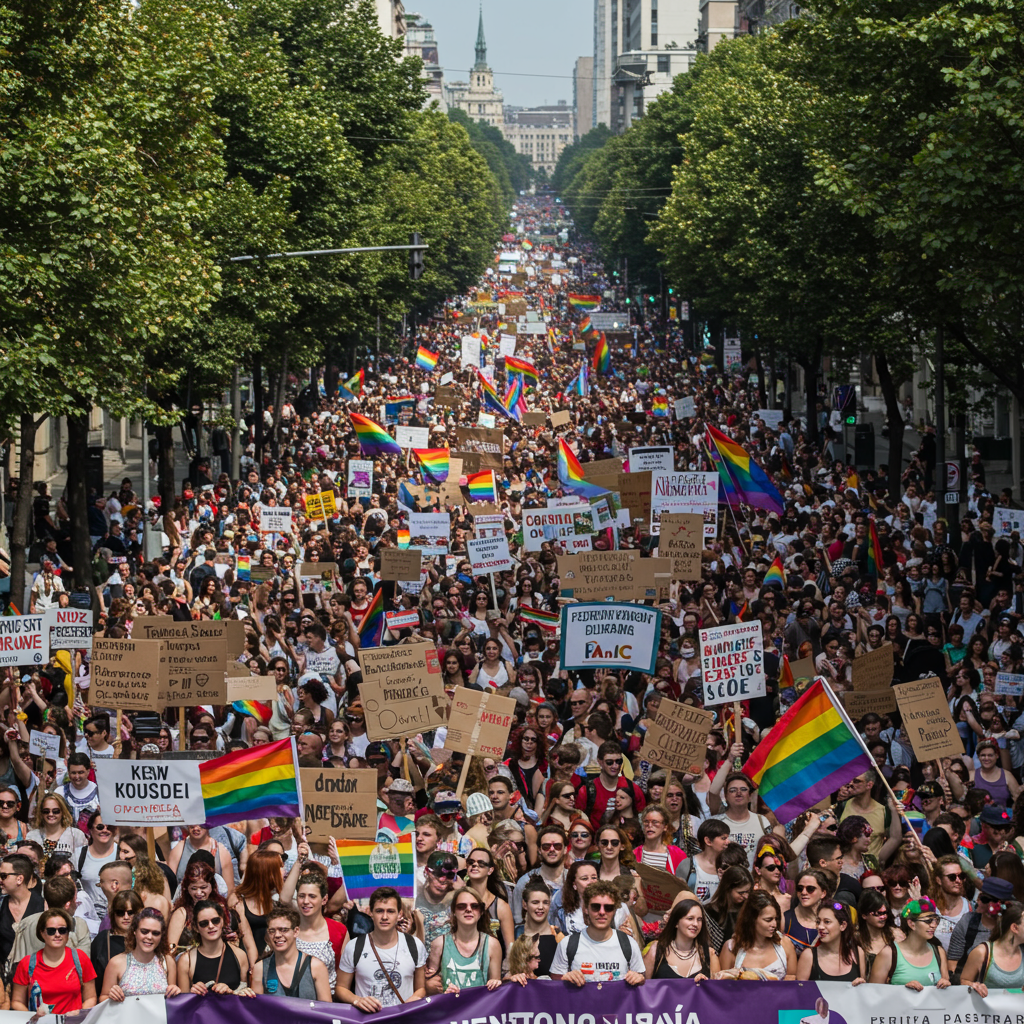Budapest, Hungary faces a pivotal moment as the annual Budapest Pride parade is set to proceed this weekend, directly defying a government ban enacted by Prime Minister Viktor Orban’s administration. This high-stakes confrontation pits civil society and international support against the nationalist government, creating a significant political challenge for Orban and his ruling Fidesz party. The event is expected to draw tens of thousands, making it a potentially record-breaking demonstration of resilience and demand for LGBTQ+ rights in Hungary.
Hungary’s Ban on Pride: A Political Calculation
In march 2025, Hungary’s parliament, dominated by Viktor Orban’s Fidesz party, passed legislation effectively banning gatherings like Pride parades. This law was justified by invoking the 2021 Child Protection Law, which prohibits the public promotion of homosexuality to minors. The government framed the new measure as a necessary step to protect children.
However, many politicians and analysts viewed this legislative maneuver differently. It appeared designed to create a political trap for Hungary’s rising opposition leader, Peter Magyar of the Tisza party. The hope, seemingly, was to force the conservative Magyar to take a stance that would expose him as either “soft on child protection” or out of step with liberal democratic norms, thereby mobilizing Fidesz’s core conservative voter base, particularly in rural areas. This strategic focus on the Pride march aimed to regain political initiative that Fidesz had recently struggled to maintain, trailing Tisza in polls.
Justice Minister Bence Tuzson even sent letters to foreign embassies warning of “legal consequences” for organizing or attending the march, including potential jail time for organizers and fines for attendees. This strong stance underscored the government’s intent to enforce the ban.
Defiance from City Hall: Recasting the Event
Despite the national government’s clear prohibition and warnings, the liberal mayor of Budapest, Gergely Karacsony, took a bold step to ensure the march would still happen. The capital city government announced it would organize the event itself, recasting it as a “Day of Freedom.”
Mayor Karacsony argued that a municipal event celebrating Hungary’s recovery of full freedom following the Soviet troop withdrawal in June 1991 does not fall under the same legal restrictions as a standard public assembly targeted by the new law. He explicitly stated in communication with the police that the event would be “not Pride,” featuring “no trucks, no dancers, no sexuality in any form,” portraying it purely as a demonstration for freedom. His intention was to bypass the police permit requirement typically needed for demonstrations.
Mayor Karacsony publicly dismissed the government’s threat of a jail sentence for organizers, suggesting such a move would only boost his popularity. His defiance positioned the city administration directly against the national government’s authority on this issue.
The Legal and Practical Hurdles
The police in Budapest, however, banned the city-organized “Day of Freedom” event nonetheless. Budapest police chief Tamas Terdik issued a 16-page document justifying the prohibition. The police reasoned that even without overt displays, the simple presence of a gathering representing the LGBTQ+ community along a public route could not guarantee with “absolute certainty” that minors under 18 would not be bystanders. This possibility, they argued, constituted a potential breach of the child protection law referenced by the government.
Under the revised legal framework stemming from the March 2025 law and earlier constitutional changes strengthening the legal basis for such bans, authorities can impose significant penalties. Attendees identified by police, potentially using facial recognition technology, face fines ranging from €14 to €500. Organizers, if held liable, could potentially face up to a one-year prison sentence.
Human rights groups, like the Hungarian Helsinki Committee (HHC), have issued advice to potential participants. They recommend refusing on-the-spot fines and pursuing appeals if they receive official notifications by post. The HHC suggested that a massive turnout might complicate widespread enforcement efforts across the police and court systems.
A Show of Force: Turnout and Solidarity
Organizers and Mayor Karacsony anticipate a massive turnout for the event. Predictions range from tens of thousands to over 50,000 participants, potentially making it the largest Pride event ever held in Hungary. This scale is intended to serve as a powerful public repudiation of the government’s anti-LGBTQ+ policies and the attempt to suppress public assembly.
The march is expected to draw not only Hungarians but also a significant international presence. Over 70 Members of the European Parliament and mayors from several EU countries are anticipated to attend. European Commissioner for Equality Hadja Lahbib is also expected, expressing solidarity and emphasizing that the right to peaceful assembly must be protected across the European Union. More than 30 embassies have publicly expressed their support for the march. European Commission President Ursula von der Leyen has also urged Hungarian authorities to permit the parade.
Domestically, over 70 Hungarian civil society organizations, including the Hungarian Civil Liberties Union and Transparency International Hungary, have issued an open letter supporting the march. They argue the law used to ban the event is intended to intimidate society at large, not just the LGBTQ+ community.
Orban’s Dilemma: Enforcement or Impotence?
Prime Minister Orban now faces a difficult decision. His government enacted the ban and issued warnings of legal consequences. Yet, suppressing a massive, internationally supported demonstration could draw significant negative attention and accusations of authoritarianism. Trying to physically break up the march would risk confrontation and potentially overwhelm authorities.
Speaking on state radio, Orban indicated that police would not physically disperse the event. He stated, “Hungary is a civilised country, a civic society. We don’t hurt each other.” However, he reiterated that while there would be no physical force, there “will be legal consequences.” This suggests a strategy of post-event legal action rather than immediate confrontation on the streets.
Letting the march proceed without immediate intervention, despite the explicit ban, risks making the government appear impotent and its ban unenforceable in practice, at least for mass gatherings. This could undermine the government’s image of strength and control.
Meanwhile, the political opposition faces its own challenge. The Tisza party, currently leading Fidesz in some polls, has adopted a cautious stance. While not explicitly declaring the march lawful, they insist that attendees deserve state protection. Their press office stated that Peter Magyar has called upon police to protect citizens, including during the march, even if it means opposing “the arbitrariness of power.” Magyar himself is not expected to attend.
Broader Context: Hungary’s Conservative Shift
The conflict over the Budapest Pride parade is part of a decade-long trend under Viktor Orban’s government. Fidesz has systematically pursued a conservative Christian agenda, restricting the rights and visibility of sexual and gender minorities. This includes constitutional amendments legally recognizing only two genders and an intensified public campaign against “gender and LGBT ideology,” which Orban often portrays as an imposition from Brussels.
The government has suggested alternative, enclosed locations like stadiums for future Pride events, highlighting its desire to remove public displays of LGBTQ+ identity from streets and public view, especially where children might be present. This approach underscores the fundamental clash between the government’s vision of a traditional, Christian society and the demands for open expression and equal rights by the LGBTQ+ community and its allies.
The stage is set for a significant public event that tests the limits of government authority and civil defiance in Hungary. The outcome, both on the streets this weekend and in the subsequent legal and political fallout, will have important implications for the future of democratic freedoms and LGBTQ+ rights in the country.
Frequently Asked Questions
Why did the Hungarian government try to ban Budapest Pride?
The Hungarian government, led by Prime Minister Viktor Orban’s Fidesz party, attempted to ban the Budapest Pride parade by enacting a new law in March 2025. This law cited the earlier 2021 Child Protection Law, which prohibits displaying content promoting homosexuality to minors. The government claimed the ban was necessary to protect children, but critics argue it is part of a political strategy to mobilize conservative voters and suppress democratic freedoms ahead of upcoming elections.
What are the potential legal consequences for people attending the Budapest Pride march?
Despite the government ban and police prohibition of the event, Prime Minister Orban stated police would not physically disperse attendees. However, he warned of “legal consequences.” Under recent laws, individuals identified by police, potentially using facial recognition technology, could face fines ranging from approximately €14 to €500. Organizers could face more severe penalties, including up to a one-year prison sentence. Human rights groups advise attendees on how to appeal potential fines.
How did Budapest’s mayor attempt to circumvent the government’s ban?
Budapest Mayor Gergely Karacsony, a liberal politician, attempted to bypass the government’s ban by designating the march as a municipal event. He recast it as a “Day of Freedom” celebrating national sovereignty, arguing that such an event organized by the city administration did not require a police permit and did not fall under the restrictive laws targeting public assemblies. He aimed to frame it as a non-sexual, freedom-focused event to avoid the government’s “child protection” justification for the ban, though police ultimately prohibited this municipal event as well.
Conclusion
The upcoming Budapest Pride march represents a critical standoff in Hungary’s ongoing political and cultural struggles. By proceeding despite a government ban, organizers and city officials have created a direct challenge to Viktor Orban’s authority and his administration’s restrictive policies targeting LGBTQ+ rights. The massive expected turnout, coupled with significant international backing, transforms this event from a simple parade into a powerful symbol of defiance and a test of democratic freedoms. The government’s response, balancing its desire to enforce the ban with the risks of cracking down on a large, peaceful assembly, will be closely watched both domestically and abroad, shaping the narrative around civil liberties and the rule of law in Hungary for the foreseeable future.
Word Count Check: ~1050 words
References
- stratnewsglobal.com
- www.bbc.com
- www.inkl.com
- <a href="https://www.lemonde.fr/en/hungary/article/2025/06/19/hungary-police-ban-budapest-pride-march-but-mayor-vows-to-hold-it-anyway6742500220.html”>www.lemonde.fr
- sarajevotimes.com




